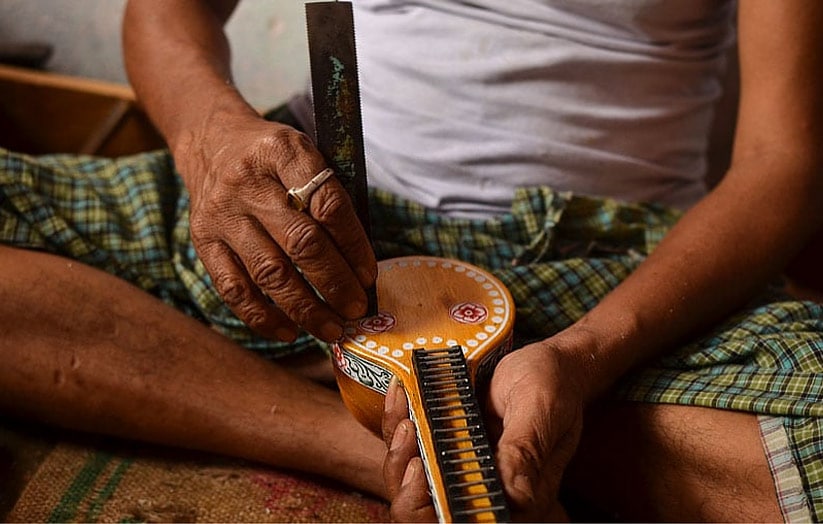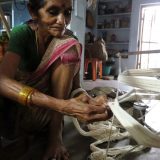Bobbili ~ a look into the culture & state of Veena today!


The tune was setting a background for all life to begin throbbing once again. Birds… One! Two! … Many! soon began to clean off the sky layer by layer, sweeping it with wing strokes. As grey gave way to a beautiful honey drenched blue sky, activities started getting visible on the horizon. The music started playing a few notes higher. Wander could visibly be seen mixing up with wonder now. “What is this new sound stirring our souls so sweet.”

It’s neither struggling for attention, nor is it disturbing any activity taking place in regular course… like fragrance of jasmine and roses, it flows smoothly, evoking devotion in all that it touches… setting a note for the day to follow…

The village maidens were engaged in tending to the cattle, preparing food for family… Men began collecting milk from cows… soon they were given their Tiffins and bid goodbyes to. Carrying milk containers to be deposited at the center, they left for a hard day’s work at the fields… the tune still ringing in their ears… making every act of toil playful, every falling sweat drop nourishing the earth. Day in & day out, a farmer blends his soul with his soil for life to emerge out of it… and today was no exception… until a palanquin carried by a pair of singing porters appeared on the trail… all of a sudden from nowhere! as if they had fallen from the sky. A new bride is being carried! The gaze in their eyes was of amazement no less than that of someone witnessing a UFO.

Cheer & merriment soon filled up the atmosphere. It’s time to welcome & introduce a new member to the village. “So & so’s daughter from so & so village has been wed into our village, to so & so’s son…” sang on the porters… Carrying her to some of the most important village family houses… Of all the virtues of the new bride, her talent in playing a specific kind of string instrument, carried by her from her village, known for its skilled craftsmen was disclosed… Bobbili Veena, from the village of Bobbili.

The village is said to have been chosen by the king Sveta Chalapati Rangarao for making of this instrument for the quality of sound the craftsmen here could achieve was to be found nowhere else. Veena, the soul of Carnatic music finds place in the hands of a number of deities from mythology. For the iconic Swaraswati, the goddess of knowledge & wisdom, painted with a Veena in her hands, Veena is also popularly known as Swaraswati Veena today and is often given a lion head at the top of its lute to distinguish it from the rest. It is noteworthy here that Bobbili was the name given to the fort by Peddarayadu under the rule of Nizam who had gifted him a huge chunk of land for his gallant services. Bobbili means “the royal tiger“. Another version of story says that it was actually Rayadu’s son who built the fort and made Bobbili as his capital and called it “Pedda-pulli” (meaning big tiger in Telugu). Pedda-pulli became Pebbuli, which in turn became Bebbuli and then Bobbili in time. The iconic lion head of Bobbili veena could very well be a reminder of this very story. Narad muni traverses three Lokas, singing lores of Vishnu & tales of one Loka in another with a specific kind of Veena called the Tambura in his hands...

S.G Acharya, a 56 years old master with 40 years of experience behind him has had a school education only till 8th standard but was taught the skill by his father from the age of 12. He has three daughters, all are well educated & working. But since the craft has only been a domain of men, they were neither taught the skill nor is it expected of them to carry forward this tradition once their father is gone… 40 families in Bobbili are involved in this craft today & they all speak Telugu.

The town has cemented Puckka houses. People have workshops in front of their houses, along a lane that enters from the main road or the market road. People of the town are also involved as daily construction laborers now since that pays them better than how much they get as skilled artisans. Bobbili is well-connected through bus stands & railway stations within the town. Agriculture is another prime source of income here. The place is surrounded by corn fields and vineyards; Ragi is cultivated and made into a high energy soup, drank in this area. The land owing to its high fertility has a huge vegetable cultivation. In their food, a staple diet of rice & Charu (Rasam) is a must. Spinach, Moong dal, Papad of white gram is also eaten. Mainly Dusshera, Deepawai, Ogali sankranti are celebrated by them & they worship a Local Deity called as Daditalli Amavar, meaning big mother. A festival called Pandaga is celebrated for the deity.
The instrument is made in a very specific way. Viswa Bhramins are the only community (Sarvasiddhi, Alachingi and Tumarada) involved in making of it since ancient time. The wood to be used, to begin with, is only that of Jackfruit tree… It has been tested over many years to produce the best kind of sound… The tree has to be a mature one, one that is at least half a century old, for the kind of girth of trunk needed to make a single piece Veena out of. This means a heavy plantation of such trees today can only yield usable wood about 50 years from now. This often makes a single piece technically right Veena an instrument of great finesse & rarity, only to be custom made for musicians and ….
“A Veena cannot be a Veena, if it is not made from a single piece of wood”.
Bobbili also makes Sitar and Tambura, yet another kind of string instruments similar to Veena. A Tambura has a bottom made of hollowed Gourd shell (Sarakaya) attached to the neck separately. It has four strings as compared to Veena, which is adorned with seven. The difference between all of the above string instruments lies in the posture of holding, their sound & the school of music they follow. Apart from Bobbli other places where Veena is made are Tanjavur & Mysore but these too are sold and bought as Bobbli Veenas today for the fame Bobbili has gained with its customers.

“ There is a lot of sacredness associated with the craftsmanship of a fine piece Veena” says a master… sitting in his workshop chiseling Jackfruit tree wood in repetitive strokes… a process as meditative as the sound of the instrument. The wood is old, seasoned to get a golden yellow tint & has a good grain quality. His hands slide down the lute to its head. “Only Bobbli artisans can make an Ekanda Veena; the one which is from head to base made from a single wood piece.”
In old times, the wood was commissioned by the kings of that time who appointed the artisans of Bobbili for the great task of making a technically perfect Veena, the one with a single piece wood, creating the right kind of sound, unparalleled by those made anywhere else or with any other kind of wood. The ball behind it is made of hollowed dry gourd shell and is for the balance and is the only piece apart from metal strings and brass frets attached separately…. However, it does not have much to do with the sound of the instrument. It is only to hold it right in the posture… balancing it on the thigh and shoulder while it is held by the musician or to balance it on the floor when it is rested, it also gives it a visual balance. Everything about this instrument starts and ends with balance.
“For the balance of the person, his posture & instrument, it is important.”
One single person makes the entire … and takes around one months’ time. Over the years the artisans develop an understanding of the sound and it takes many years for someone to achieve the kind of skill needed to make a perfect sounding Veena with series of testing and refining processes.
To make the best instrument with full potential, a master takes 6 months’ time. 30 days to make the body, rest to make soul.

Choosing a musical instrument is a very personal decision, depending upon a person’s own sound quality and musical preference they choose a musical instrument. It is further more personalized by people’s own ergonomics changing the size of the instrument they hold. Their taste of aesthetics decides the patterns painted on it and ornamentation done on top. Though the basic proportions of a Veena never change. The biggest size available is 56 inches & the smallest one comes in ten inches. Swaraswati Veena at one end has a lion’s head… while some may prefer this, there are people who get it design in the form of a swan head or completely turned lotus petal..
The challenges faced by the craftsmen are the high taxes on wood because of its shortage or unavailability and the low prices they get against such high level of skill. A full size Veena fetches an artisan anything around Rs.25000, which is usually not enough for a family of five or more to sustain for the duration it takes to make it. Nowadays, the artisans have stopped making the full size ones. They are only made on demand. The artisans only make decorative pieces like miniature Veenas, Tambura & other string instruments now, of ten inches or more. There have been no modulations however in the design of Veena since its origin & in the words of a master “if it has to come to an end, it will come to end just like this”. The craft will exist only for a few years if we don’t plant more Jackfruit trees and if we all don’t learn how to play Veena….

Mesmerized with these stories of Bobbly, a classroom full of young girls & boys holding their Veenas in front of them… made specially to their body size, the resonator head in front of their tiny laps & the top nub right above their shoulders, looks at their new teacher with beaming eyes. They are drenched in devotion like blooming flowers, ready to receive the pollen of knowledge brought to them by their Didi, a busy bee engrossed in preimbuing the fresh minds with her music, like Saraswati herself.
Read more about Craft ~ Gaatha.org











OP ARYA
Dear Sir
Today I saw your site , Really very nice efforts by you for all artiest .
I am share your website to all my friends and relative
Best Wishes for your excellent work ….
OP Arya
Bhilwara Raj. 311001
9352111281